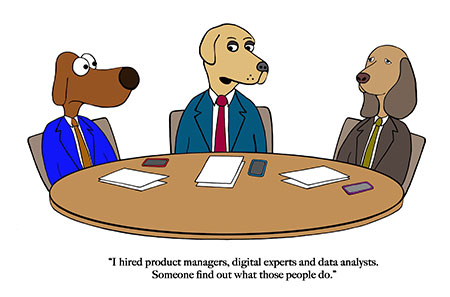Building Customer Value Proposition in Today’s Information Age
Publish Date: January 11, 2019A ship is always safe at the shore, but that is not what it’s built for – Albert Einstein
Your Value Proposition Isn’t What You Do!!! More important than what your value proposition is, is how you present your value proposition. The value of your proposition is the value that’s determined by your prospect or customer — not you. A value proposition should end in whether or not your prospect or customer shows interest in the products or services you are providing. So, a value proposition must start with understanding your prospect and what their pain is. Listening is the key element in delivering your value proposition [2].

– Albert Einstein.
According to a survey, nearly 50% of businesses don’t have a clearly defined digital strategy.
Brands that outperform peers share a standard set of characteristics including a focused growth strategy, strong value proposition, and differentiated positioning. Gartner defines a brand as the combination of elements, including name, logo, positioning, stories, and experiences, that differentiate a company and its offerings in increasingly competitive markets. The value you promise must correspond with the value you deliver to your customer [4]
Gartner Highlights Three-Step Process Technology Providers Can Implement to Craft a Unique Value Proposition. These steps include –
Step 1: Analyze value from a price/performance perspective.
Step 2: Analyze your business proposition.
Step 3: Put “value” and “proposition” together, and by quantifying the business outcome and experience that a customer can only get from a specific provider, marketers get much closer to constructing a value proposition that only they deliver.
Digital disruptors have also introduced the concept of value vampires, which shrink the overall revenue and profit pool in a market to gain competitive advantage.
Consistent alignment of capabilities and internal processes with the Customer Value Proposition is the core of any strategy execution. –Robert S. Kaplan
There is abundant availability of data all around, and this information, in turn, decides everything that happens around it too. Businesses have always been using this data and the technology to improve their processes and productivity. But what has changed is that customer expectations have also increased with the availability of information. Information is available at their fingertips and is being used for everything, be it entertainment, shopping, socializing, finding jobs or paying bills. The question now is – “How can businesses best respond to this shift and take advantage of the data to innovate, differentiate and grow?” Also, how can they do all this cost efficiently and effectively leveraging the latest information technologies?
Businesses with the right strategy for integrating both their digital and physical elements can successfully transform their business models – and surge ahead. They need to focus on both reshaping customer value propositions and transforming operating models using digital technologies for greater customer interaction and collaboration.
Better the data, better decisions can be made. Customer experience is defined as every touch point someone can have with your brand. Customer journey orchestration ties each touch point a customer can have, and the related measurements and data sources interact and get the customer the information needed. By using a customer journey orchestration framework and tools, sync of data between systems occurs and would be able to see points in customer experience that are inefficient or ineffective and measure the value and risk.
In B2B marketing, the ability to anticipate the needs of customers’ industries and quickly deliver information and solution proposals to the right people can become key to marketing success. The better understood – market, target personas, the trends in industry and product differentiators, the more equipped to attract ideal prospects and convert them into customers [3]. Business managers need a better understanding of the drivers of the business value. According to a Wharton research study, companies that build and verify a set of leading indicators earn a 2.95% higher return on assets and a 5.14% higher return on equity. Fewer than 25% of companies attempt this.

A major force of transformation is the surge in devices and their Connectivity, be it smartphones, tablets, or the ever-emerging social networks. These are creating an exponential explosion in data, which, in turn, requires business analytics to make sense of the data and take full advantage of it. Customers also have a range of new choices and decisions about what they should focus on or buy are increasingly influenced by social media. Mobility has visibly eliminated the boundaries of space and time. Customers are always connected, and with product information becoming as important as the products themselves, almost all businesses are now creating and delivering “content” – information that is personal, relevant and timely when accessed by the customer.
Mobility, social media and digitization are creating a wave through all industries, as connected customers and employees move past traditional boundaries.
Conclusion
Businesses today are under intense pressure to rethink their customer value propositions and operations. They are constantly integrating new and traditional processes and evaluating its impact on their customers. Businesses that take a proactive position in the digital revolution and leverage the full potential of disruptive technologies are:
1. Reshaping customer value propositions
2. Re-modeling their business operations to deliver new customer value propositions effectively, efficiently and in innovative ways
3. Doing both at the same time, which leads to the broadest industry transformation.
The path to digital transformation will vary by industry, and every business is under pressure to change and needs to have a plan in place.

Lakshmi Nanduri -Program manager @YASH Technologies
References:
- Domo’s – Data Never Sleeps
- https://www.forbes.com/sites/forbesagencycouncil/2017/11/27/your-value-proposition-isnt-what-you-do/
- In B2B Marketing, Better Delivers More – https://www.forbes.com/sites/forbesagencycouncil/2017/04/13/in-b2b-marketing-better-delivers-more/
- Branding and Value Proposition Primer for 2018 – https://www.gartner.com/doc/3841873/branding-value-proposition-primer-
- https://www.gartner.com/newsroom/id/1034913
- http://images.gartnerformarketers.com/Web/Gartner/%7B917ad319-57ad-411e-8b6d-17784b6a3084%7D_Branding___Value_Proposition_FINAL.pdf?_ga=2.49631845.299636709.1545387278-529705490.1499170818
- https://www.forbes.com/sites/forbesagencycouncil/2018/10/04/how-to-calculate-the-value-of-customer-journey-orchestration/#33178f1042b5
- https://www.gartner.com/doc/2379317/gartner-business-value-model-framework
- https://www.forbes.com/sites/martinzwilling/2016/09/05/how-to-create-customer-value-and-profit-to-survive/#2ef75931bc1f


















